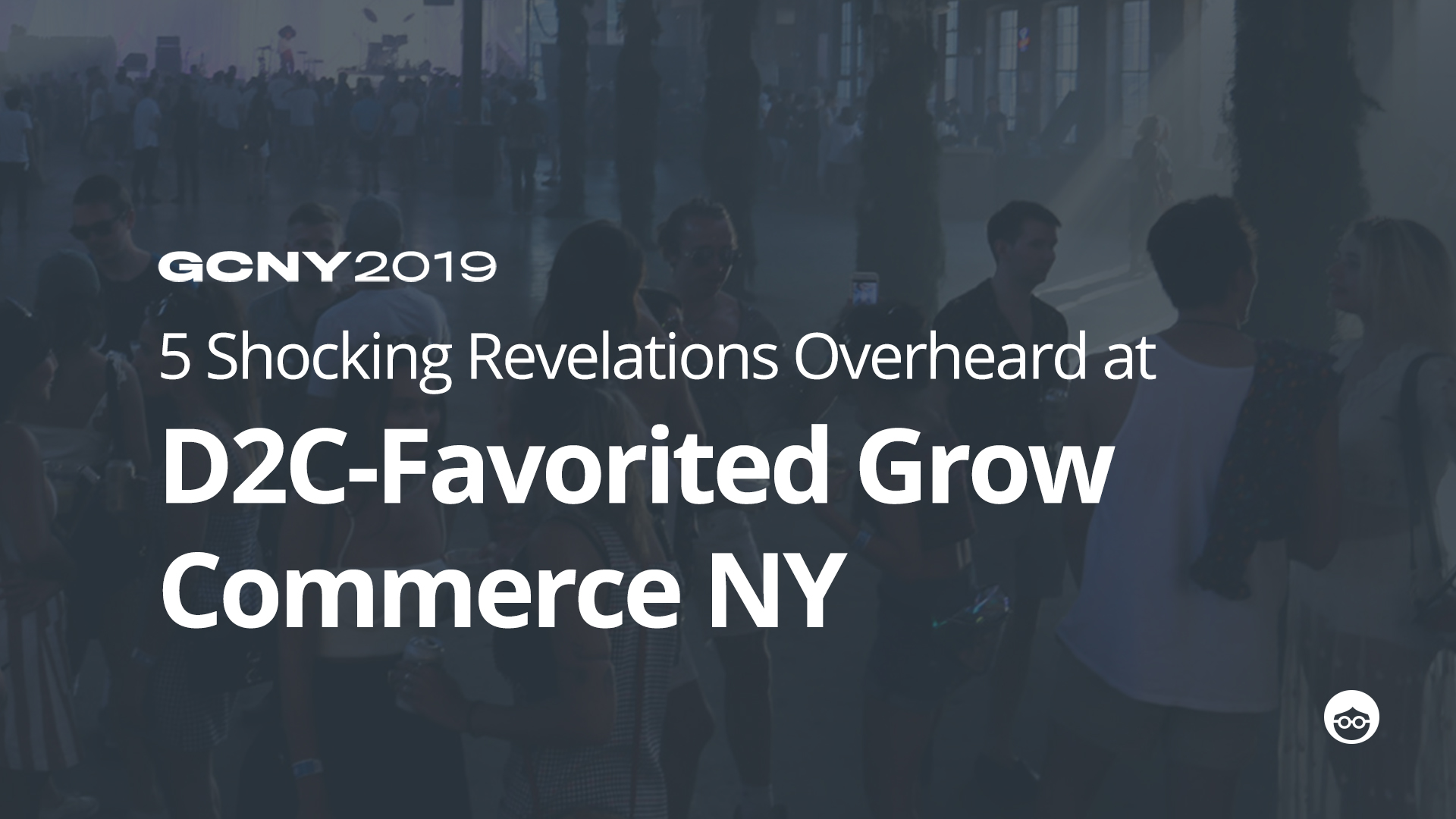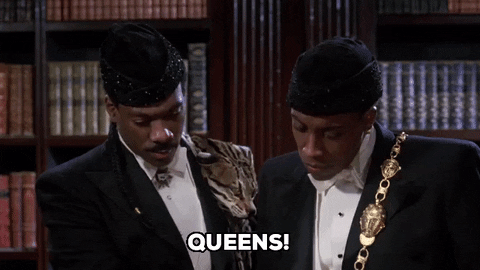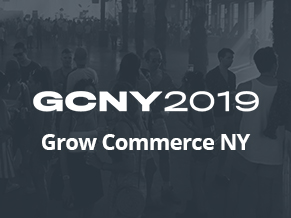5 Shocking Revelations Overheard at D2C-Favorited Grow Commerce NY

Grow.co landed in none other than Queens this week for it’s inaugural Grow Commerce New York, well-attended by the “high-growth and at-scale retail brands” to watch.

Image: Giphy
We’re talkin’ Founders, C-Suite Executives, and Growth Marketing Experts from the likes of Parachute, Google, Mack Weldon, Bombas, and Walmart — the full D2C-to-traditional brand spectrum.
Upon entering GCNY, the initial shock factor (aside from a NY event hosted in a borough outside of Manhattan, of course) came with the full experience.
Grow.co didn’t host any ol’ conference — they hosted a conference fit for the attendees joining them. Extremely cool space, hip branding, live painters, food trucks, dancing DJs, and best of all, legitimately insightful content.
And the shock didn’t stop there. With that legitimately insightful content came legitimately shocking revelations — 5 of the most shocking listed below for all of those who didn’t get to experience GCNY this year.
-
Disingenuous Giveback Programs Are Felt
Ever been enticed to purchase a product because it gave back to the greater community? Ya know, the whole ‘if you buy one, we’ll donate one’ routine?
Well, there was no shortage of leaders calling out the disingenuousness felt from brand-to-brand all the way to brand-to-consumer.
Matt Scanlan, Co-Founder & CEO at Naadam, a sustainable Mongolian cashmere brand, had no shortage of words to say about the matter.
“The give-one get-one model is bullshit,” said Scanlan, describing non-profit work as a symbiotic relationship, exclaiming “we’re better because they’re better.”
He, and others, believe that you can build businesses simply to do good things, and make better business decisions because that’s simply the right thing to do. And to come from a place of humility, understanding perfection is unachievable, so long as you try and don’t hide the imperfections of the process along the way.
Scot Tatelman, Co-Founder at State Bags, separately agreed in his session about getting real. “Customers are too savvy to tell what’s real from what isn’t,” said Tatelman, which helped inspire his company’s shift from the one-for-one method to merely helping all American families who needed it, no matter what help was needed.
💡 Brainy Tip: Start the foundation of your business around a meaningful purpose or value, and have that be your guiding light for every business decision you make, from product to marketing, and beyond.
-
D2Cs Are Turning to (And Launching With) Big Brands
D2C, or direct-to-consumer, is just that — it’s a business model where brands cut out the middleman, building digitally, while streamlining the process for greater efficiency and owned experience.
Though shockingly enough, we’re seeing those same D2C brands turning to big, traditional brands to further maximize revenue potential.
Take Quip, for example — providing tech-forward oral care to the masses. Not only is Quip launching multiple dental care plans, they also started wholesaling through Target this year — a big box retailer — outside of the norms of a typical, digital-first D2C.
While most consumer data is lost through a third-party retailer like Target, Shane Pittson, Head of Marketing at Quip, described the launch as a seamless integration, since Target is an “experience-led retailer” and “more than just products on shelves.”
We heard a very similar experience through the eyes of Savannah Sachs, CEO at Tula, a health-forward skincare brand that simultaneously launched digitally and through a third-party retailer, Ulta. Sachs described this as an omnichannel approach, and though data can’t be gained directly, the brick & mortar approach allowed for greater customer convenience by “meeting them where they are.”
Taking the shock a step further, many D2Cs also claimed to be spending more marketing dollars offline than online. Yes, the same D2Cs that started digitally-savvy, are turning back to traditional ways of reaching the customer. TV, radio, out-of-home, pop-ups, print — you name it, D2Cs are diversifying their ad spend there.
Pittson at Quip admitted to spending more dollars offline, echoed by the Chief Product Officer at Zenni Optical, Bia Gan, who mentioned that Zenni “is seeing more conversions offline since online is becoming more and more expensive.”
💡 Brainy Tip: Don’t be afraid to shift toward traditional forms of marketing, so long as you have a strong digital presence beforehand. Remember, go offline to build online (a strong point made by Luke Droulez, the CMO at Parachute).
-
Money Is Not Where Brands’ Mouths Are
Facebook was a hot (and very cold!) topic.
Diversifying marketing budgets away from Facebook was an always-on conversation, heard throughout the full-day event. Yet, when it came down to it, most brands admitted to spending a majority of their budgets with Facebook (especially Instagram).
Digitally, Facebook is where a number of these brands are experiencing the most cost-efficient conversions, short-term, though are realizing that the bigger picture expands much further beyond the walled gardens of social.
Whether online or offline, it’s very clear that performance-driven brands are on the lookout for the next big thing — whatever is going to help drive acquisition, while providing the best experience for their current, and future, customers.
💡 Brainy Tip: Here’s a not-so-shameless plug… eMarketer found that consumers trust native ads (like Outbrain!) 24.4% more than social ads. You can reach your most interested customers outside of the walled gardens, and on the most premium, trustworthy feed of the open web. Discover the experience for yourself.
-
Even D2Cs Aren’t Utilizing Data (Enough)
D2C brands are known for a handful of key differentiators — one of which is that they are data-driven brands that utilize said data to allow for a more personalized customer experience.
But shockingly enough, even D2Cs aren’t using their customer data well enough.
During her presentation on the Age of Personalization, Therese Parkes, Head of Industry, Disruptive Retail at Google, stated that 85% of brands that have the data today aren’t utilizing it.
Google also found while 40% of consumers are more likely to spend more than initially planned when brand experiences are highly personalized, 64% of consumers will actually avoid a brand if they experience a poor personalization experience.
And as we know, this goes much beyond the “Hi, [Insert Incorrect First Name]” email kickoff, but trickles all the way down to understanding the preferable products or services wanted and the cadence of communications of which to send per individual.
The biggest takeaway presented by Google: there’s $400 billion dollars in global revenue potential of personalization vs. non-personalization. Billion.
💡 Brainy Tip: Consumers are savvier than ever — they want personalized experiences without sharing their personal data, and that’s okay! Formally define the “creepiness factor” of personalization for your brand, and find the happy medium of personalization based on specific target audiences of yours, and how they like to interact with you.
-
“Engagement” Is Smoke And Mirrors
This might have been the most shocking of them all. Are you ready?
“Engagement” and “experience” are two of the buzziest words in Marketing today. Many believe that brands must engage with their audiences and provide experiences to help deepen the connection and overall relationship.
Just as we see D2Cs turning to brick & mortar — it’s all about creating a live experience that you can own from start to finish — the look-touch-feel effect.
Interestingly enough, many of the speakers at GCNY were arguing against that point, most distinctly Taylor Coil, the Director of Marketing at Tortuga, a travel gear brand focused on ease, bluntly stated, “our audience doesn’t give a shit about being engaged.” Continuing, “we want to be a part of their lives by solving real problems for our customers… and that’s when the community-building happens.”
Sachs again from Tula hit a similar point about finding opportunities based on your customers actual needs, after the brand found success rolling out an acne line upon deciphering that over 40% of their customers had difficulty with the skin condition.
💡 Brainy Tip: Engagement (i.e. positive customer support experiences) and Experience (i.e. providing memorable brand moments to drive loyalty) are still vital in our current marketing climate, as we’re surrounded by constant up-and-coming brands that can gain market share quicker than ever. But the main driver for every brand should revolve around the smallest viable audience, and what value or solution you’re providing to them, growing holistically from there.
Jaw-dropping, huh?
It all comes down to one thing, really — we’re all just trying to figure it out!
Technology is changing faster than we can snap our fingers, consumers are getting more and more savvy, processes like manufacturing are accessible to average humans, not just large conglomerates — things have changed, and are changing every day, and we merely have to adapt.
But we all love a good shock factor! And Grow Commerce NY brought no shortage of those. Would highly recommend attending next year, if you missed this one.
Interested in maximizing performance through native ads? Be sure to leave us a note to set up a time to chat, or see the experience for yourself.











